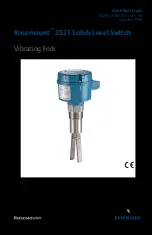
2.1.11 Rotatable housing and fork orientation mark
The standard housing can be freely rotated to get the best position after
being mounted to a process. On type 'D' and 'DE' housings, a fixing screw
must first be loosened before the housing can be freely rotated. When the
best position is achieved, re-tighten the fixing screw. Never force the
rotation of the housing beyond the physical limits.
Figure 2-3: Housing Rotation and Fork Orientation Mark
A
C
B
A. Threaded process connection
B. Housing
C. Fork orientation mark on hexagonal boss (or sliding sleeve if fitted)
2.1.12 Orientation of cable glands
When the level switch is mounted horizontally, ensure the cable glands are
pointed downwards to avoid water getting inside the housing. Unused
conduit entries must be completely sealed with a suitably rated stopping
(blanking) plug.
2.1.13 Seals
Apply PTFE tape to the threaded process connection. This is required for a
silo (or other vessel) to maintain the process pressure.
2.1.14 Future maintenance
It is advisable to grease the screws of the housing cover (lid) when a
corrosive atmosphere is present. This will help prevent difficulties when the
cover needs to be removed during future maintenance tasks.
2.1.15 Switching point
Heavy bulk materials
The signal output switches over when the forks of the level switch are
covered a few millimeters.
October 2020
Quick Start Guide
Quick Start Guide
13














































